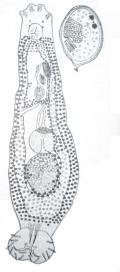| Back to Back Issues Page |
 |
|
The Goldfish Gazette, Issue #047 -- Parasite Control November 30, 2017 |
Goldfish Care Tips and GuidelinesA Free Monthly Resource For Goldfish Enthusiasts In This Issue
Goldfish, like any animal, are susceptible to parasites. Parasite Control
If a fish is lethargic, lacks appetite, has excess body slime or is twitching, suspect parasites. Some parasites are quite large and obvious, while others require a microscope to be seen. And often it isn’t the largest that are the most likely to be fatal, it is the smallest. Sometimes it is a secondary symptom the owner sees and treats for without realizing parasites are the primary problem. Fungus is an excellent example of this. Fungus is often caused by flukes, and fungus treatments won’t kill flukes.
Causes of Parasite OutbreaksA parasite outbreak occurs because the fish’s immune system has been weakened, or the parasite has been introduced from new arrivals or water plants. An aquarium or pond is a closed community. If a healthy fish carrying a few parasites is introduced into a closed community of healthy fish, an outbreak can occur because they haven’t built up immunity to a particular pathogen. The opposite is also true for a new arrival. If it is introduced into a closed community of disease resistant fish, and its immune system hasn’t encountered a parasite the community is carrying, it quickly gets sick. Parasite TypesParasites can be divided into three broad categories, crustacean, worm, and protozoan. In some types of infestation, fish health plays a large part in an infestation spreading. In others fish in excellent health are preferred by the parasites. This is particularly true for crustacean parasites such as Anchor worm (Lernaea cyprinacea) and lice (Argulus). Starting with the larger crustacean parasites, these parasites are always introduced by new arrivals or on water plants. Lice can be seen with the naked eye as a 1/8th (3mm) flying saucer that can be green in color or from my own experience translucent and quite hard to spot. Anchor worm appears as a small harpoon sticking into the side of the fish. It can be a variety of colors from white, yellow, tan or dark green. Where the worm is embedded into the skin a red spot appears. An outbreak is more common in the fall. Both these parasites are on the low end of the dangerous scale unless there are large numbers attached to a fish sucking so much blood the fish becomes anemic. Parasitic worms are more common, and can be more deadly, especially to smaller fish. The two most common are gill flukes (Dactylogyrus) and body flukes (Gyrodactylus). They are a problem for fish under 2” or 52mm body length. They are very hard to see, near impossible on a red/gold colored fish, but can be seen on Black Moor as tiny white worms the largest about 1mm long. It takes practice to spot them without a microscope. Flukes are introduced from new arrivals and fish with low immune systems will be attacked. Flukes don’t suck the blood of Goldfish but feed on the body slime after attaching themselves to the skin. It is the attaching that does the damage. Flukes will kill smaller fish. Fry are particularly susceptible and a whole brood can be wiped out in days. Another worm parasite that can affect Goldfish is tapeworms, but these are uncommon and can be treated using medications used for flukes. The last group of parasites, and the deadliest, are the protozoan parasites. These include Costia, Chilodonella, Hexamita, Ich, Oodiium and Trichodina. They are introduced by new arrivals or using contaminated equipment. What makes this group of parasites particularly dangerous is that apart from Ich (white spot) which has obvious symptoms, unless you have a microscope and know what you are looking at, they are very hard to identify. This group of parasites attack fish of any size that has a weak immune system. Quarantine MethodsThe first rule when quarantining new fish is, assume they have parasites and treat accordingly.For crustacean parasites observation over several weeks is all that is necessary. If none appear in that time then they haven’t got any. For flukes and protozoan parasites, assume they have them. Even healthy fish will carry some, and to stop introducing any into your Eco-system, you need to use a proper Praziquantel based medication, not just a mild salt bath. To read about parasite treatments available for the different groups of parasite, click here…
Green Water UpdateIt's now 5 weeks since starting the second Splosht test, and I still can't report a favorable result with a clear pond.The water has gone from a pea soup green to a milky green color so something is happening. I'll keep up with the test until the bacterial sachets have been used up to see if I can get a result. I've contacted the manufacturer for advice, but so far no reply. If any readers have had success with this product please drop me an email. Comments? Ideas? Feedback? I'd love to hear from you. Just reply to this e-zine and tell me what you think, or what topics you want covered. Next Month's Topic Bacterial Diseaseswww.facebook.com/aboutgoldfish |
| Back to Back Issues Page |